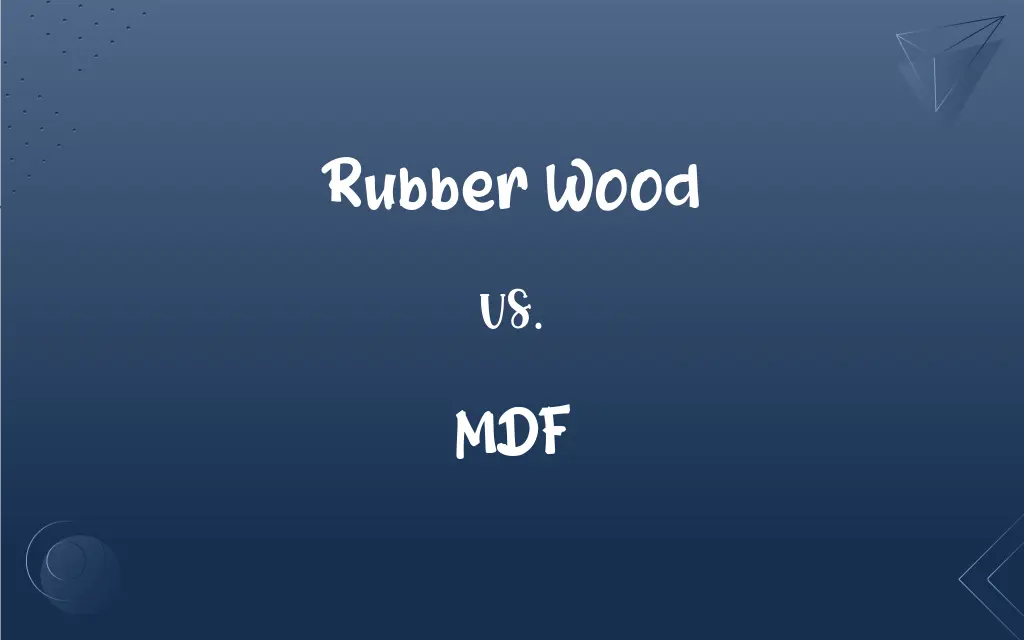Rubber Wood vs. MDF: What's the Difference?
Edited by Janet White || By Harlon Moss || Updated on June 10, 2024
Rubber Wood is a durable hardwood derived from rubber trees, while MDF (Medium-Density Fiberboard) is an engineered wood product made from broken-down hardwood or softwood residuals.

Key Differences
Rubber Wood refers to the hardwood harvested from rubber trees, primarily found in parts of Asia. Conversely, MDF, or Medium-Density Fiberboard, is manufactured by combining wood fibers with a resin binder under heat and pressure.
In the context of sustainability and eco-friendliness, Rubber Wood is often heralded for being an environmentally responsible choice due to its origin from renewable rubber trees. MDF doesn’t share the same level of eco-friendliness due to its manufacturing process which involves various chemicals and binders.
Considering strength and durability, Rubber Wood boasts a solid structure, often utilized in furniture due to its durability and workability. MDF, while smooth and consistent, does not offer the same strength and can be vulnerable to damage when subjected to high impact or moisture.
Rubber Wood, with its light color and pronounced grain, offers a visually appealing, natural aesthetic that is often appreciated in various products. In contrast, MDF provides a smooth surface without a grain, which may lack the natural appeal but offers a perfect canvas for paints and veneers.
From a cost perspective, Rubber Wood often comes with a higher price tag due to its durability and natural origin. MDF tends to be more budget-friendly, offering a cost-effective solution for numerous applications, despite its lower strength and durability.
ADVERTISEMENT
Comparison Chart
Material Origin
Natural hardwood from rubber trees
Engineered wood made from wood fibers and resin
Sustainability
Often considered eco-friendly
Less eco-friendly due to its manufacturing process
Durability
Relatively strong and durable
Less durable and prone to damage from moisture
Appearance
Features a natural wood grain
Smooth surface, no grain, ideal for painting
Cost
Typically more expensive than MDF
Generally more cost-effective than Rubber Wood
ADVERTISEMENT
Rubber Wood and MDF Definitions
Rubber Wood
Often considered an eco-friendly material.
Choosing Rubber Wood supports sustainable practices due to its renewable source.
MDF
An engineered wood product made by combining wood fibers with a binder.
MDF is a preferred choice for many indoor furniture pieces because of its smooth surface.
Rubber Wood
Prized for its workability in various applications.
The flexibility of Rubber Wood makes it a favorite among carpenters and designers.
MDF
Generally more affordable than natural hardwoods like Rubber Wood.
The cost-effectiveness of MDF makes it popular in budget-friendly furniture designs.
Rubber Wood
A hardwood obtained from rubber trees.
Furniture made from Rubber Wood tends to be sturdy and durable.
MDF
Known for its smooth, non-grained surface.
MDF provides a flawless surface for painted furniture and decorative pieces.
Rubber Wood
Known for its light color and visible grain.
The natural grain of Rubber Wood adds aesthetic appeal to interior designs.
MDF
Easily shaped and customized for various applications.
MDF can be crafted into intricate designs, making it versatile for detailed work.
Rubber Wood
Typically more expensive than engineered wood like MDF.
Despite its higher cost, Rubber Wood remains popular for its durability and look.
MDF
Vulnerable to damage from moisture and heavy impacts.
Care should be taken to protect MDF furniture from water spills to avoid damage.
FAQs
Does Rubber Wood accept stains and finishes well?
Yes, Rubber Wood accepts stains and finishes quite well, allowing for a versatile range of aesthetic finishes.
Can Rubber Wood be used for outdoor furniture?
While Rubber Wood can be used outdoors, it must be properly treated and sealed to prevent damage from external elements.
How does MDF respond to water exposure?
MDF tends to swell and degrade when exposed to water, as it is not water-resistant.
Is MDF suitable for detailed carvings and intricate designs?
MDF is not ideal for detailed carvings due to its fiber-based composition, though it can be used for simpler, engraved designs.
Is Rubber Wood resistant to water and moisture?
Rubber Wood has a moderate resistance to water but is not entirely waterproof or resistant to prolonged moisture exposure.
How does Rubber Wood impact the environment?
Rubber Wood is often regarded as an environmentally friendly option since it utilizes wood from rubber trees that have ceased latex production.
How does Rubber Wood fare against pests like termites?
Rubber Wood isn’t particularly resistant to pests like termites and may require additional treatments to enhance its resistance.
Is Rubber Wood available globally?
Rubber Wood is widely available, particularly in regions with substantial rubber tree plantations like Southeast Asia, but can be sourced globally.
How does the weight of MDF compare to other wood materials?
MDF is generally heavier compared to other engineered wood products of the same thickness due to its dense composition.
Is MDF suitable for outdoor use?
MDF is not recommended for outdoor use due to its susceptibility to moisture and relative fragility in fluctuating conditions.
Are Rubber Wood furniture pieces heavy?
Rubber Wood has a moderate weight, not as heavy as some hardwoods, but it’s sturdier and heavier than MDF.
What types of projects typically use MDF?
MDF is widely used for interior projects, such as cabinetry, shelving, decorative wall panels, and furniture, due to its smooth surface and workability.
What is the lifespan of furniture made from Rubber Wood?
Furniture made from Rubber Wood can have a substantial lifespan, especially when properly cared for, potentially lasting for several decades.
Can MDF be painted easily?
Yes, MDF can be painted easily due to its smooth surface, and it often provides a clean, finished look when painted.
What are the environmental concerns related to MDF?
The production of MDF involves various chemicals, and it doesn’t biodegrade as efficiently as natural woods, presenting several environmental concerns.
Is MDF prone to termite attack?
Yes, MDF is susceptible to termites and doesn’t have natural repellent properties against pests.
How does MDF furniture compare in longevity to Rubber Wood?
MDF furniture generally has a shorter lifespan compared to Rubber Wood, especially if it is exposed to moisture or heavy use.
How does Rubber Wood impact allergies?
Rubber Wood is not commonly associated with allergies, but the latex production from the same trees can be an allergen to some.
Is MDF a safe material in terms of indoor air quality?
MDF can emit formaldehyde, a VOC (Volatile Organic Compound), so ensuring it is properly sealed and used in well-ventilated spaces is crucial for maintaining indoor air quality.
Can Rubber Wood be carved and detailed easily?
Rubber Wood has a fairly easy workability, allowing it to be carved and detailed without excessive difficulty.
About Author
Written by
Harlon MossHarlon is a seasoned quality moderator and accomplished content writer for Difference Wiki. An alumnus of the prestigious University of California, he earned his degree in Computer Science. Leveraging his academic background, Harlon brings a meticulous and informed perspective to his work, ensuring content accuracy and excellence.
Edited by
Janet WhiteJanet White has been an esteemed writer and blogger for Difference Wiki. Holding a Master's degree in Science and Medical Journalism from the prestigious Boston University, she has consistently demonstrated her expertise and passion for her field. When she's not immersed in her work, Janet relishes her time exercising, delving into a good book, and cherishing moments with friends and family.































































